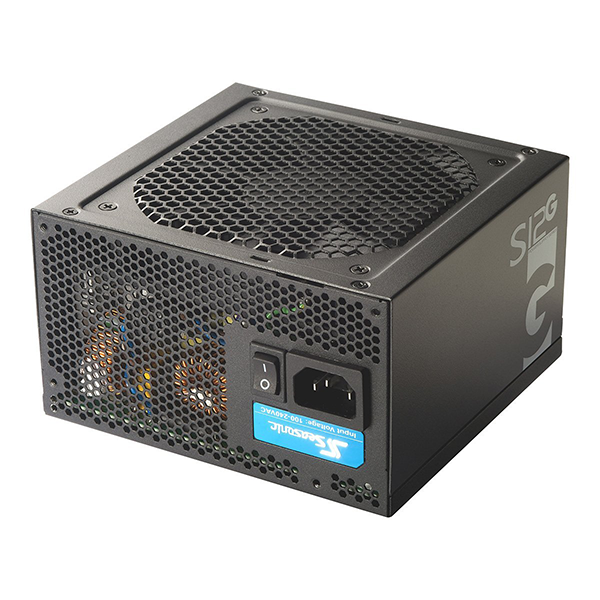SilverStone SX500-LG Power Supply Review
SilverStone's SX500-LG fits into the new SFX-L form factor. It's longer than normal SFX units, allowing for a larger fan that reduces output noise.
Why you can trust Tom's Hardware
Load Regulation, Hold-Up Time And Inrush Current
To learn more about our PSU tests and methodology, please check out How We Test Power Supply Units.
Primary Rails And 5VSB Load Regulation
Load Regulation testing is detailed here.
The following charts show the voltage values of the main rails, recorded over a range from 40W to the maximum specified load, and the deviation (in percent) for the same load range. You will also find a chart showing how the 5VSB rail deals with the load we throw at it.

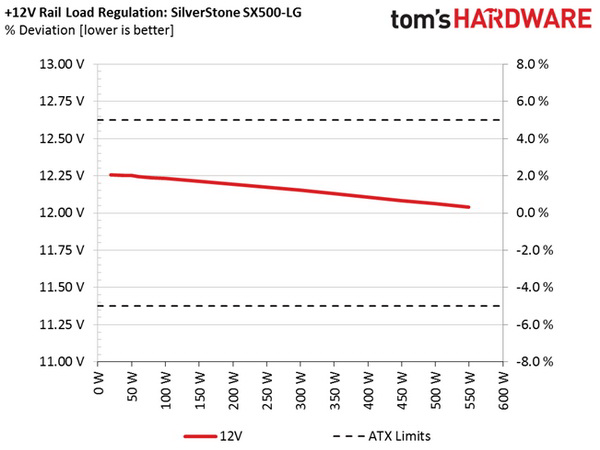
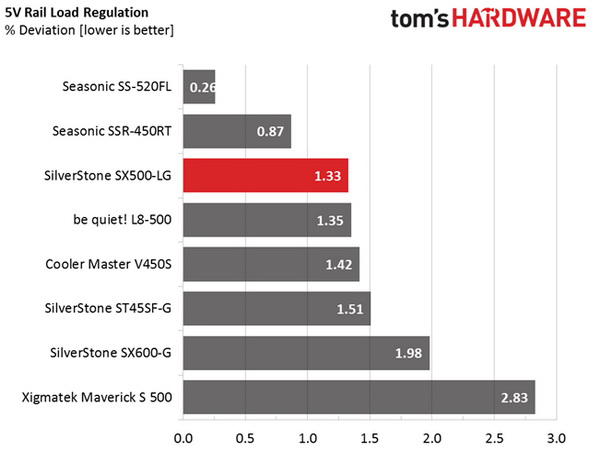


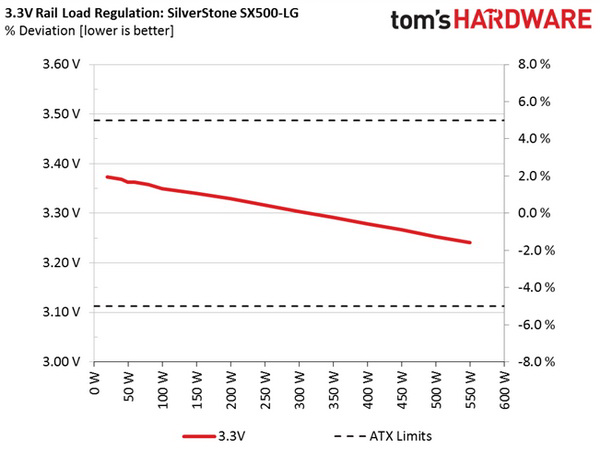


Hold-Up Time
Our hold-up time tests are described in detail here.


The hold-up time is very long—one of the best we have ever measured.
Inrush Current
For details on our inrush current testing, please click here.
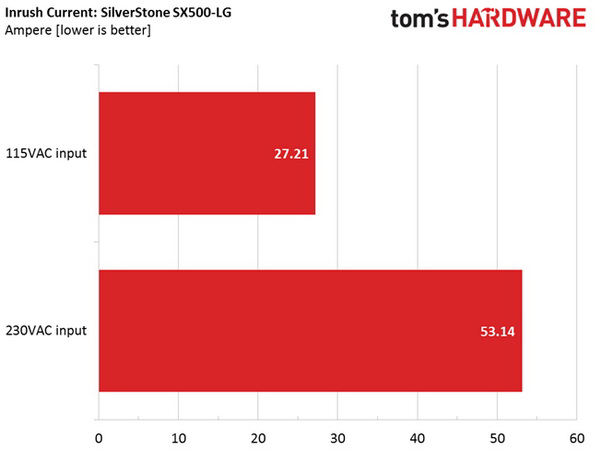
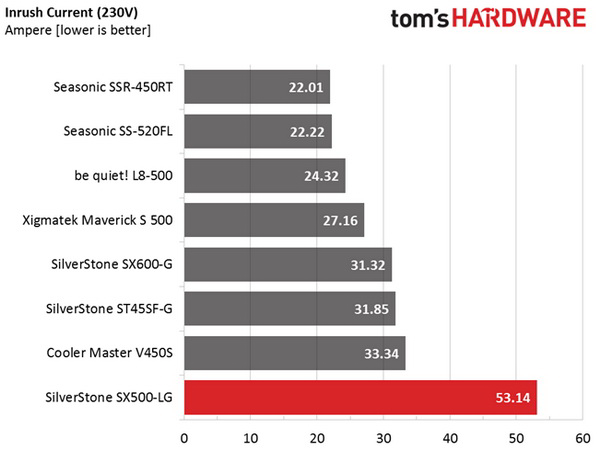
The inrush current is higher than that of other similar-capacity units, but it is still low enough that it won’t cause problems.
Get Tom's Hardware's best news and in-depth reviews, straight to your inbox.
Load Regulation And Efficiency Measurements
The first set of tests revealed the stability of the voltage rails and the PSU's efficiency. The applied load equals approximately 10 to 110 percent of the maximum load the supply can handle, in increments of 10 percentage points.
We conducted two additional tests. During the first, we stressed the two minor rails (5V and 3.3V) with high loads while the load at +12V was only 0.10A. This test revealed whether the PSU was Haswell-ready. In the second test, we determined the maximum load the +12V rail could handle while the load on the minor rails was minimal.
| Test | 12V (A/V) | 5V (A/V) | 3.3V (A/V) | 5VSB (A/V) | Power DC/AC(W) | Efficiency (%) | Fan Speed (RPM) | Fan Noise dB(A) | Temp In/Out (°C) | PF/AC (V) |
|---|---|---|---|---|---|---|---|---|---|---|
| 1 | 2.300A | 1.952A | 1.960A | 0.981A | 49.76 | 83.38 | 850 | 28.6 | 38.29 | 0.976 |
| 12.253V | 5.117V | 3.363V | 5.099V | 59.68 | 40.46 | 115 | ||||
| 2 | 5.632A | 2.926A | 2.952A | 1.180A | 99.73 | 87.27 | 885 | 29.8 | 37.49 | 0.988 |
| 12.233V | 5.109V | 3.350V | 5.083V | 114.28 | 39.97 | 115 | ||||
| 3 | 9.318A | 3.431A | 3.470A | 1.379A | 149.87 | 89.16 | 1015 | 31.9 | 38.55 | 0.993 |
| 12.212V | 5.100V | 3.340V | 5.069V | 168.10 | 41.24 | 115 | ||||
| 4 | 13.007A | 3.921A | 3.963A | 1.580A | 199.75 | 89.93 | 1130 | 34.8 | 38.77 | 0.996 |
| 12.194V | 5.092V | 3.329V | 5.053V | 222.11 | 41.9 | 115 | ||||
| 5 | 16.370A | 4.915A | 4.975A | 1.786A | 249.76 | 89.94 | 1300 | 39.8 | 41.38 | 0.997 |
| 12.173V | 5.085V | 3.316V | 5.036V | 277.70 | 44.67 | 115 | ||||
| 6 | 19.750A | 5.900A | 5.992A | 1.992A | 299.75 | 89.64 | 1425 | 40.3 | 41.84 | 0.997 |
| 12.152V | 5.078V | 3.303V | 5.017V | 334.40 | 45.65 | 115 | ||||
| 7 | 23.139A | 6.901A | 7.017A | 2.200A | 349.73 | 89.20 | 1510 | 40.7 | 42.61 | 0.997 |
| 12.129V | 5.071V | 3.291V | 4.997V | 392.09 | 47.16 | 115 | ||||
| 8 | 26.537A | 7.896A | 8.053A | 2.409A | 399.67 | 88.67 | 1570 | 41.4 | 42.76 | 0.998 |
| 12.107V | 5.065V | 3.278V | 4.979V | 450.76 | 47.91 | 115 | ||||
| 9 | 30.379A | 8.405A | 8.602A | 2.415A | 449.70 | 88.05 | 1700 | 42.7 | 43.31 | 0.998 |
| 12.084V | 5.057V | 3.267V | 4.967V | 510.75 | 49.4 | 114.9 | ||||
| 10 | 33.975A | 8.914A | 9.131A | 3.033A | 499.58 | 87.23 | 1770 | 44.3 | 44.9 | 0.998 |
| 12.065V | 5.048V | 3.252V | 4.939V | 572.74 | 51.69 | 114.9 | ||||
| 11 | 38.189A | 8.935A | 9.164A | 3.043A | 549.49 | 87.23 | 1780 | 44.3 | 45.45 | 0.998 |
| 12.040V | 5.036V | 3.241V | 4.927V | 637.16 | 53.42 | 114.9 | ||||
| CL1 | 0.102A | 13.013A | 13.005A | 0.003A | 111.48 | 87.23 | 1525 | 41.1 | 43.26 | 0.992 |
| 12.203V | 5.148V | 3.324V | 5.069V | 136.51 | 49.29 | 115 | ||||
| CL2 | 39.965A | 1.002A | 1.003A | 1.002A | 495.08 | 88.40 | 1750 | 43.7 | 43.83 | 0.998 |
| 12.054V | 5.024V | 3.279V | 5.012V | 560.07 | 49.95 | 114.9 |
Load regulation was pretty tight on the +12V and 5V rails, though at 3.3V it exceeded three percent. Nonetheless, what really matters is the +12V rail's performance, which feeds most of a modern system's components. In this case, that rail performed well. Our efficiency measurements show that the unit easily cleared the 80 PLUS Gold requirements with 20 percent and 100 percent load, and missed 90 percent efficiency by a very small margin with a typical (50 percent) load. Therefore, we will give it a pass, since we measure at much higher temperatures than the 80 PLUS organization.
The 120mm fan proved to be silent enough, even under highly stressful conditions like the ones we applied during our high-load tests. When the fan was at full speed, its noise output didn’t go above 45 dB. In addition, the fan handled the heat load efficiently, allowing the PSU to operate without any problems as the hot box exceeded 45 degrees C (113 degrees F).
Current page: Load Regulation, Hold-Up Time And Inrush Current
Prev Page A Look Inside And Component Analysis Next Page Efficiency, Temperatures And Noise
Aris Mpitziopoulos is a contributing editor at Tom's Hardware, covering PSUs.
-
Giannis Karagiannis Nice review! Indeed, the price is high but this is common with non standard ATX size PSUs. Apart from the high price it looks like a very good unit however.Reply -
PaulBags I'm waiting to see the 700w platinum version of this in review. If we can get a 700w platinum sfx-l, how long until we can get shorter and/or higher wattage fanless atx?Reply -
Aris_Mp I will ask for their 700 W model as well.Reply
As for higher wattage fanless ATX units, only with Titanium efficiency (for less energy dissipation) -
jtd871 YMMV, but there are people who have reported a galloping or chirping noise associated with this model. It's not clear if it's the fan, the thermistor that turns the fan on and off or a combination of both. Based on the ambient testing temps for this review, it might not have been noticed or noticeable. Discussion on for those wanting more info.Reply -
Aris_Mp Haven't noticed anything weird in my sample, else I would have mentioned it in the review.Reply -
Vlad Rose Still not compatible with their first generation Raven RVZ01 models. Be careful if you buy one through an online retailer as you might get back stock as Silverstone never bothered to call it a revision change..Reply -
mikelim2000 Got the same PSU, no weird sound, almost dead silent. My PC is dead silent, no case fans, only other fan is the Be Quiet! Shadow Rock LP for my cpu and that's literally dead silent.Reply
-
ThePSU Honestly....Aris no mean to offend you but you barely explain how you test these, what equipment you use, or anything. Just a bunch of oscillating graphs is not making you a confident reviewer to me. One must reveal how they come up with these numbers in detail and equipment used. Otherwise until I can myself replicate these things, your reviews are utterly useless to me.Reply -
Aris_Mp I am not easily offended no worries. There is a whole article about this. And also there are links to this article right before each new test, in all of my reviews. For me as well a reviewer that doesn't share is methodology and equipment isn't a trust worthy one.Reply
http://www.tomshardware.com/reviews/how-we-test-psu,4042.html


